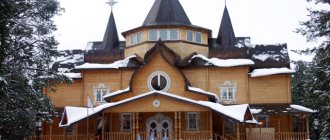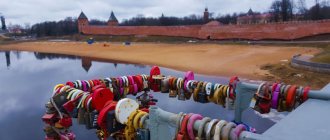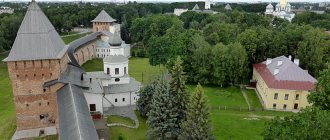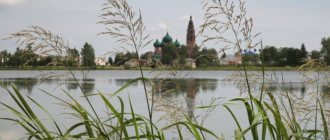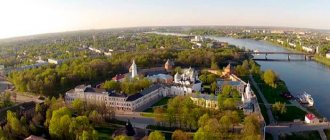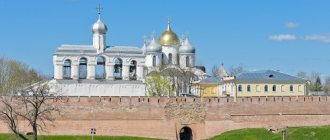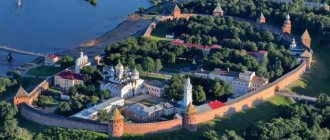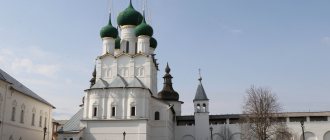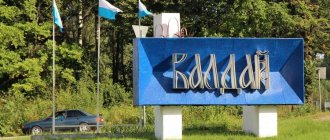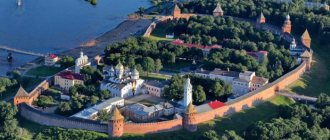Veliky Ustyug is an ancient city in the Vologda region, allowing you to understand the soul of the Russian North, see its amazing flavor and feel its unique charm. The attractions of Veliky Ustyug help travelers with this.
For a long time, this city, located on the left bank of the Sukhona River, despite the abundance of ancient churches, monuments, and museums, was not very developed in the tourism sector.
However, thanks to a joint project with Moscow, operating since 1998, the creation of a brand: Veliky Ustyug - the birthplace of Father Frost, the flow of tourists has increased significantly. Especially in the winter season. Thus, the sights of Veliky Ustyug are now known to many Russians and foreigners.
A few facts about Veliky Ustyug
Monument to Erofey Khabarov in Komsomolsky Square
- It was first mentioned as a guard settlement in 1207.
- Previously it was called simply Ustyug.
- Occupies an area of 17 square meters. km, the population as of 2021 is more than 31.5 thousand people.
- Located on the left bank of the river. Sukhona near the source of the Northern Dvina.
- The distance to the regional city of Vologda[/anchor] is 450 km, to the largest city in the region Cherepovets - 580 km, to the capital of Russia - 914 km.
How to get to Veliky Ustyug
By car
From Moscow along the M8 highway (Moscow - Arkhangelsk) through Yaroslavl and Vologda. After Vologda turn to Totma.
By bus
From Moscow (Medvedkovo metro station) to Vologda, there transfer to a bus going to Veliky Ustyug.
By train
Trains do not go to Veliky Ustyug, you need to get to Kotlas Yuzhny or Yadrikha station. From there by bus to Veliky Ustyug. Trains from Moscow depart from Yaroslavsky station, from St. Petersburg from Ladozhsky.
By plane
There is an airport in Veliky Ustyug; air transportation is carried out by the Severstal company. Cons - there are no direct flights; you can only get from Moscow (Sheremetyevo and Domodedovo) and St. Petersburg with a transfer in Cherepovets. The transplant can take a long time.
Sights of Veliky Ustyug
The main attraction of Veliky Ustyug, the residence of Father Frost, is located not in the city itself, but about 12 kilometers from it. The Santa Claus project, which made the city famous, is already 20 years old. Over the years, a tourism industry has been created with hotels, cafes and a variety of entertainment.
In Veliky Ustyug there are a large number of architectural monuments - temples, monasteries, houses. There are many museums here.
One of the most ancient Russian cities
The Rostov-Suzdal princes once founded a settlement on this site, which was named Gleden. The city got its name from the name of the river Yug, at the mouth of which it was located. A lot of buildings have been preserved here, reflecting the heritage of the ancient state. The style of construction of the cathedrals and churches of the city is very ancient and was no longer used in later buildings.
There are no ancient wooden buildings in this ancient city. The reason for this is a big fire that happened here at the end of the 16th century. 7 churches and more than 700 residential buildings were destroyed in its fire. Therefore, residents erected new buildings from stone. Of course, there are wooden houses in the city, and even very beautiful ones, but they were built much later.
Residence of Father Frost
Website: www.dom-dm.ru. Address: Vologda region, Veliky Ustyug district, Mardengskoe village, territory of Father Frost's Estate, no. 1.
The sights of Veliky Ustyug are unthinkable without the residence of Father Frost. In the northern part of the city there is a beautiful place in a pine forest where Santa Claus lives. Usually the existence of the residence is remembered in the winter, but it welcomes guests all year round. Everything has been done here to create a festive and fabulous atmosphere.
The main object of the residence is the house of the famous fairy-tale hero. This building was built in the best traditions of Russian architecture, the main material of which has long been wood.
Next to the fairy-tale tower there is the magical post office of Father Frost. Here they accept letters for Santa Claus and answer them.
On the territory of the residence there are guest cottages for visitors who want to stay here for a while. As well as the Ded Moroz cafe and the Snezhinka restaurant, which serves traditional Russian dishes. In addition, there are playgrounds for children, souvenir shops, a zoo, a rope park, a glacier, a winter garden and much more interesting things.
Attractions with children
Since 1999, Veliky Ustyug has been considered the home of Father Frost, which is why thousands of children are brought here, reinforcing their belief in the New Year’s miracle. Many exciting excursions and interactive activities aimed at young tourists are held in the city's museums.
Residence of Father Frost
The place of attraction of winter Veliky Ustyug is the Estate of Father Frost. It is located in the middle of a pine forest in the outskirts of the city. Guests are greeted by fairy-tale characters whose huts are located on the “Trail of Fairy Tales” on the way to the wizard. Moroz himself occupies a carved two-story tower. In it you will see an office where all the miracles happen, a bedroom, a dressing room and a wizard’s library. At the end of the excursion there is a long-awaited meeting with Santa Claus in the Throne Hall of the tower.
Main Russian Frost Photo: © Marina2506
The farm of Father Frost is not limited to this and also includes: a post office, a glacier - a gallery of ice sculptures and an ice throne, a forge and a carpentry workshop, a zoo and a winter garden, a forest pharmacy. In each, educational and creative programs are organized for visitors. In addition, there is a cafe and restaurant, a hotel, souvenir shops on the territory, and for entertainment there are attractions and slides.
Read more: Santa Claus's house
Tower of Father Frost Photo: © Marina2506
At the City Residence of Father Frost at lane. Oktyabrsky, 1 guests will be told the history of the holiday, the wizard and his homeland. As representatives of Veliky Ustyug, the cultural center of the region, children will be occupied with creative master classes on creating a wicker belt, a painted birch bark souvenir or a “shark” rattle.
Nearby there is a small blue tower - Santa Claus's post office , where thousands of letters arrive from children from all over the world. The storyteller's assistants will tell you about the most unusual wishes, show you old postcards and offer to send news from the homeland of Santa Claus to friends and family.
Veliky Ustyug and at least 15 other places where Father Frost lives
Santa Claus Mail Photo: © Sergey Vasilets
Museum of New Year and Christmas toys
The theme of the holiday fairy tale in Veliky Ustyug will be continued by the Museum of New Year and Christmas Toys. A significant part of it is occupied by Russian Christmas tree decorations made of glass, wood, felt, birch bark, pumpkins, and cotton wool. Among them are original ones and those published in thousands of copies throughout the country.
With Christmas trees decorated according to decades, adults will be able to remember their childhood, and children will be able to get acquainted with school supplies and learning traditions in past years. This is the subject of the interactive lesson “Lessons in the Old Russian School”. A separate hall expands the geography and reveals the canons of New Year celebrations in other countries.
In the Museum of New Year's Toys Photo: © vladkonst
The museum occupies the Church of the Myrrh-Bearing Women . This is a common practice in the city, preserving architectural monuments where services are not currently held. The temple was erected in the first quarter of the 18th century. Its appearance has original details: scrolls above the window casings, a high porch and tiles in the design of the facades.
Read more: Museum of New Year and Christmas Toys
Children's Museum Center
The Children's Museum Center is an exhibition and leisure area for children and their parents. It occupies another architectural monument in the city center - the house of the Alenev icon painters, later sold to the merchant Chebaevsky. The building has a corner in the form of a covered rotunda with a balcony; one of the facades is decorated with antique columns and porticos.
Guests of winter Veliky Ustyug have access to exhibitions dedicated to the New Year and its attributes. Thus, the exhibition “Let the Christmas Tree Not Go Out” takes you back to the times of the pre-revolutionary and Soviet holiday, presenting the decor, fancy dress costumes, decorated Christmas trees, traditional and unusual Christmas tree decorations. The exhibition “Our Soviet Childhood. Toys from the 40s to the 80s. XX century." It surprises young people and immerses adult visitors in the best moments of childhood.
Usov House - Children's Museum Center Photo: © Sergey Vasilets
At the center's master classes, children independently decorate a New Year's toy in the style of Veliky Ustyug painting or create a souvenir from foil using the filigree technique. The most tireless are offered a game in which participants will learn about the significance and price of the achievements of the Ustyug explorers S. Dezhnev and E. Khabarov.
Read more: Chebaevsky's house
Sukhona embankment
Veliky Ustyug is located on the banks of the Sukhona at the confluence of the Yug River, which later gives birth to the Northern Dvina. To look at the wide, beautiful Sukhona hidden under the ice, go to the embankment. It starts from Krasnoarmeyskaya and stretches 3 km downstream of the Sukhona. The most interesting part for a walk is the part adjacent to the city center. There are activities for both children and adults here.
Veliky Ustyug embankment Photo: © Marina2506
While parents are looking at the line of city blocks with the domes of churches, children can swim in the snow to their hearts' content or ride down the slides going down to the river. It’s worth walking to Lenin Square : from November onwards there is a New Year’s tree , because on November 18th the birthday of Father Frost is celebrated. Closer to the river there is a sundial dedicated to the residents - famous travelers of past years.
“Aquarius” Photo: © Sergey Vasilets
The embankment runs past the Church of St. Nicholas , now the Museum of Ethnography , past the Cathedral Courtyard - a temple complex, the heart of ancient Ustyug. It also houses the Museum of History and Culture of the City and the Museum of Nature . In front of them on a bench sits E. P. Shilnikovsky - a monument to the artist and head of the Ustyug silver factory "Northern Chern". Another street sculpture is “Aquarius” , the coat of arms symbol of the city, personifying the unity of Sukhona and the South.
At the bottom of the embankment stands the stone church of Simeon the Stylite . It was built in 1765 and is distinguished by its rich architecture. Round windows, unusual frames, pilasters and a high main staircase refer the architecture of the temple and bell tower to Western European Baroque. The temple is open to visitors and services are held.
Church of Simeon the Stylite Photo: © vladkonst
Museum of Nature
The Regional Nature Museum is located on the city embankment and occupies an outbuilding of the house of the merchant Usov. Panoramic landscapes and animal figures show the local living world. They are complemented by the rustling of the inhabitants, the murmur of water and other sounds of the forest, thanks to which the stories become complete. In another part of the museum, an interactive exhibition has been organized, revealing the Vologda nature through the works of Russian painters.
The paleontological hall is also interactive. He talks about the times when dinosaurs and mammoths walked across the Vologda land. It will be interesting for children to take part in excavations and build a model of a whole lizard. A separate area is dedicated to the modern owner of forests - the bear. Here is everything about its structure, habits and nutrition. Guests will also be able to visit an impromptu den, light up the constellations Ursa Major and Ursa Minor, and remember the bears - the heroes of fairy tales.
Read more: Regional Nature Museum
We will list other museums in Veliky Ustyug below, since the main theme is more understandable for adults. However, many of them organize special children's excursions and events designed to tell about the cultural heritage of the city in an interesting and accessible way.
On pre- and post-New Year's dates, the Church of the Epiphany puts on a performance for children over 6 years old telling about the biblical events of Christmas night, the traditions of celebrating Christmas, and the meaning of the Christmas tree. There is also an interactive program dedicated to Christmas at the Museum of Ethnography. Family master classes on processing flax and creating a woven belt are also held there; in the Depository they introduce birch bark carving and the rituals of Russian tea drinking. The City History Museum gives you the opportunity to try bobbin lace weaving and organizes games in an old shop.
Folklore program Photo: © Irina Porunova
City residence of Father Frost
Address: Sovetsky Prospekt, building 85.
The city itself houses the city residence of Father Frost. Here you can walk around the house, try on suits, take pictures, make an entry in the Book of Good Deeds, buy souvenirs, and attend a master class.
There is also a greeting card museum, which houses the world’s largest postcard “Veliky Ustyug. Troika of Santa Claus. Its dimensions: 4.2 x 2.8 meters.
Across the road is the Cathedral Courtyard.
Oktyabrsky Lane
Oktyabrsky Lane is a street that reveals interesting facets of the history of Veliky Ustyug. Until 1804, the street was considered a suburban street, and it connected two centers of the settlement and was divided by the Arkhangelsk Gate of the Big Fortress. Only one third of the street was located within the city limits. Subsequently, the plan of Veliky Ustyug was radically changed, but the architecture of Oktyabrsky Lane still surprises with its antiquity.
Cathedral courtyard
The Cathedral Courtyard is the oldest part of the city, the heart and soul of the city. Here, on the high bank of the Sukhona River, there is a complex of ancient churches: the Assumption Cathedral with a bell tower, the Cathedral of Procopius of Ustyug, the Cathedral of John of Ustyug, the Bishop's Compound.
Assumption Cathedral
The Assumption Cathedral is the main temple of the city; the most revered Orthodox icons were located here. The stone church was built in the middle of the 16th century on the site of a wooden one - it was the first stone building in the Russian north.
Bell tower of the Assumption Cathedral
Adjacent to the Assumption Cathedral is an unusual bell tower of two parts: one is a tower with a spire and a clock, the other has a cubic end. It was added in the 18th century.
Observation deck of the Assumption Cathedral
On the bell tower of the Assumption Cathedral there is an observation deck where you can look at the city from above.
View from the Assumption Cathedral
To fully see the temple ensemble located in the Cathedral Courtyard, you need to move to the other bank of the Sukhona River - to the Dymkovo churchyard. There are beautiful views of ancient churches here.
Cathedral of Procopius the Righteous
This religious building is named after the local holy fool, considered the patron saint of the city. In 1668, a temple was erected in his honor, with the money of the local merchant A. Guselnikov, and the grave where the relics of the holy elder rested was chosen as the location. Now the sarcophagus with the relics of Procopius the Righteous is installed inside the temple.
The church is a white stone structure with blackened domes. It was rebuilt several times, but managed to maintain its original attractiveness. Among the most valuable objects of the religious institution is a five-tiered iconostasis from the 18th century. In the eighties and nineties of the last century, the cathedral was restored, after which its original attractiveness returned.
Monument to Dezhnev
Semyon Dezhnev - traveler and pioneer, was born in Veliky Ustyug. The monument to him is located on Cathedral Square next to the Memorial Wall to the Ustyuzhan Explorers.
What to see in the area
Veliky Ustyug is surrounded by meadows and dense forests, which are threaded by three large rivers. It is difficult to blame nature for anything; it is beautiful both in its snow-white robe and in the greenery of summer. Among the specific places where tourists visit, most often the forgotten monastery and the “Sukhonsky miracle” - an unusual-looking section of the Sukhona River.
Photo: © Sergey Vasilets
Trinity-Gledensky Monastery
On the other side of the Sukhona, on a hill near the confluence with the South, lies the village of Morozovitsa . People visit it to look at the ensemble of the Trinity-Gleden Monastery. The monastery was founded in the city of Gleden, now defunct. Unlike the city, it survived the civil strife of the Russian princes, and in the 17th-18th centuries. rebuilt in stone.
Now the Trinity Cathedral and the Tikhvin Church rise on the territory. Surprisingly, the institutions of the Soviet era did not violate their architectural integrity. The pearl of the cathedral is a carved, gilded iconostasis with icons reminiscent of European painting. You can explore the monastery from the outside on your own in winter or summer, but excursions inside are only available in the summer. The surrounding landscape of the monastery is always worthy of attention - the river expanses at the junction of large rivers.
Read more: Trinity-Gledensky Monastery
Opoki
One of the remarkable places in the vicinity of Ustyug that you can visit in winter is Opoki, which is 63 km from the city. This is both the rapids on the Sukhona and the steep, exposed right bank of the river near the village of Porog. The slope is composed of red and white rocks, alternating horizontal layers. A small stream washed it through, dividing it in two.
The rapids on the river are long, shallow, but fast flowing. In winter it is unlikely to be seen as the river freezes. The well is of greatest interest: the jet gushing out like a fountain creates high walls of ice. It is located on the other side of the river a kilometer below the Threshold. To get to the fountain, you need to cross to the other side. After snow, you may have to pave the trail yourself. You need to be careful on the ice; there are gullies in some places.
Read more: Opoki in the Vologda region
Ice fountain in Opoki Photo: © Kristina Kosinskaya
Church of St. Nicholas the Wonderworker
Address: Naberezhnaya st., building 66.
This temple has a long and complicated history. Its construction began back in 1682 and lasted about 40 years. However, such a long construction stage gave birth to a real masterpiece of Russian church architecture. The structure, which has several tiers, completely lacks supporting pillars. The architectural ensemble is completed by a three-tier bell tower.
At the end of the Soviet Union, the church building was restored, after which a branch of the museum with an exhibition hall was opened in it. Now this place is used for regular excursion and educational events about the traditional crafts of this region.
Spaso-Preobrazhensky Monastery
The monastery has almost 600 years of history. Its foundation dates back to 1422, when the Russian lands were part of the Golden Horde. Unfortunately, the original wooden buildings of that period have not survived to this day.
Nowadays you can see stone structures from the 17th-18th centuries. Chief among them is the Transfiguration Church, which was built over the course of 7 years (from 1689 to 1696) with an original carved gilded iconostasis made in 1697.
Church of the Ascension
Address: Sovetsky Prospekt, building 84.
The money for the construction of this temple was given by the city merchant Nikifor Revyakin, who set the condition to create a unique structure that has no analogues in the area. In 1648, an 11-domed white stone temple with a brick facade and rich decoration was built.
True, over time the church was rebuilt, and has survived to this day only in its 5-domed form, but it has retained its main features. Some time ago, restoration work began here, which continues to this day.
The church houses the Museum of Ancient Russian Art. The most valuable products created using the techniques of blackened silver, enamel, and filigree are collected here. There are also examples of artistic sewing and beautiful icon painting. Those interested can attend master classes on creating icons with their own hands. The main value of the museum is the white stone Cross of St. Procopius.
Factory "Velikoustyug Patterns"
The factory is famous for its unique products made from birch bark (birch bark). Each product is decorated with unusual carvings, weaving, and paintings.
The company has existed since 1972. It was then that the city authorities decided that the traditional crafts of Veliky Ustyug should be preserved. As a result, it was possible not only to preserve the fishery, but also to contribute to its successful development.
The factory currently produces several hundred different types of items, ranging from boxes and baskets to glass holders, souvenir cutting boards and decorative plates, caskets, and writing sets. All products are manufactured taking into account traditions.
Location: Naberezhnaya street - 1.
Veliky Ustyug Museum-Reserve
Website: ustyug-museum.ru Address: Veliky Ustyug st. Embankment 64.
The founding date of this institution is considered to be 1910. The exhibition halls display a variety of examples of church utensils, ancient icons, and many artifacts found during archaeological expeditions. The museum also contains a number of paintings by Russian Itinerant artists.
During the Civil War, atheistic Red Army soldiers tried to ruin it, and museum staff had to make a lot of efforts to preserve the collection. Now the institution has the status of a museum-reserve and has over 90 thousand items in its collections.
Museum "Russian Izba"
At a distance of about 25 km from Veliky Ustyug, in the small village of Krasavino, there is the Russian Izba Museum, which attracts a large number of tourists. Visitors can discover interesting facets of Russian antiquity, learn customs and rituals, beliefs and traditions.
The museum center allows you to see interesting items of peasant life, namely a cross, a spinning wheel, a children's shaky, a light and irons. Thematic exhibitions deserve special attention for anyone who wants to discover important aspects of their native culture.
Buldakov's estate
Address: Naberezhnaya street, 45, 46, 47
The Buldakov estate consists of 2 outbuildings and the main house, built at the dawn of the 19th century. The customer of the complex was a local merchant and head of a Russian-American company, Mikhail Buldakov. He bought the land for the estate in 1804, and 2 years later a large original house was erected on it, to which 2 outbuildings were later added, which served as office premises.
There is a park complex near the estate. Since 1995, the Buldakov estate has been a historical monument of federal significance.
Dymkovskaya Sloboda
Dymkovskaya Sloboda includes several churches located right on the banks of the Sukhona River. The construction of the very first temple took place in 1383. Nowadays, Dymkovskaya Sloboda consists of three religious sites:
- Temple of Dmitry of Thessalonica.
- Church of St. Demetrius.
- Temple of Sergius of Radonezh.
Excursions are held here. Unfortunately, the beauty of the architecture is only presented from the outside, since the entrance is closed. Despite this fact, many get the opportunity to enjoy the discovery of the religious pages of Veliky Ustyug.
Museum of New Year and Christmas toys
Address: Communy Square, 7
This establishment, attractive to people of all ages, continues the main tourist theme of the city. The homeland of the main winter character is unthinkable without wonderful New Year and Christmas toys that allow you to touch the true magic.
The museum was opened in 1998 in the now defunct Church of the Myrrh-Bearing Women, which is an architectural monument of the 18th century. Within its walls there are numerous Christmas tree decorations from different times, made from various materials (clay, wood, cotton wool, glass, plastic), fabulous figurines of angels, Santa Claus and his granddaughters, beautiful garlands, Bethlehem stars, etc.
One of the halls houses unique exhibits that tell about New Year and Christmas traditions from different parts of the world.
Glass Bottle Museum
Address: Sovetsky Prospekt, building 121 (opposite Lenin Square).
This small but unique museum for Russia appeared thanks to the efforts of Alexander Kokovin. Now there are 600 exhibits on display, most of which are dishes from the times of the Russian Empire.
Here are bottles into which alcoholic drinks were poured, as well as utensils used in perfume production and pharmaceuticals. There are also containers for milk and lemonade.
The sights of Veliky Ustyug are interesting for both children and adults and are of great historical and cultural value. They are objects of Russian cultural heritage.
Lenin Square
Lenin Square traditionally hosts concerts and New Year's celebrations. This year it was quiet, but the natural beauty was more attractive: frost-covered pines, maples, a silver snow carpet underfoot. And a huge festive tree with colorful balls and garlands, on which “Happy New Year!” was written in bright red letters. There was also an envelope with a letter to Santa Claus attached to it. I managed to send it on the eve of the new year. And I'm sure he will send an answer. The snow-white sky merged with the silver snow, and I felt peace and harmony in my soul.

